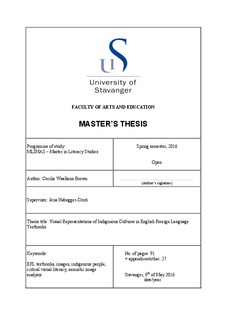| dc.description.abstract | This thesis presents an analysis of how indigenous cultures are visually represented through images in four English Foreign Language (EFL) textbooks produced for Norwegian lower secondary schools. Building on the concept that images are texts, and therefore can convey meanings, the thesis is based on the premise that images are not merely neutral reproductions of reality, but may also be carriers of ideologies. The thesis considers whether images can in fact be even more powerful than verbal texts in communicating ideologies, as images, and photographs in particular, are often perceived by the viewer to be objective and are consequently taken for granted as conveying the ‘truth’.
With the aim of investigating the extent to which images of indigenous people contribute to, or contradict, the general cultural aims of the English language learning curriculum in Norway, the study focuses on the following aspects: cultural stereotyping, power relationships and level of identification. The main method applied in the study is visual content analysis, which is a qualitative method used to measure the relative frequency of a certain class of visual content. In the thesis, content analysis is used to measure the extent to which indigenous cultures are represented through their traditional cultural heritage, rather than their present-day culture. Additionally, the aspects of power and identity are addressed through the application of concepts from semiotic image analysis, where people from both indigenous cultures and ‘white’ people were categorized and compared in relation to image composition, including the horizontal and vertical angle, the gaze and the frame.
The results from the study show that there is a strong trend, in the four textbook series evaluated, to focus on the traditional costumes and settings in the visual representations of indigenous people, with over half the images in the corpus not including any sign of modernity. Additionally, the comparative study shows that the indigenous people are more frequently depicted from a high angle than the white people, implying a trend towards representing indigenous people in a lower position of power than the viewer. The analysis of the gaze and the frame also shows that the images of indigenous people more frequently position the viewer from a long distance, as an observer, whereas the images of white people are more frequently inviting the viewer to interact and empathise with the participants. Consequently, the study concludes that the images in the four EFL textbooks analysed are, to a large degree, potential carriers of myths and ideologies that directly contradict the general cultural aims of English language learning in Norway. | nb_NO |

